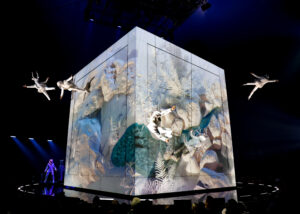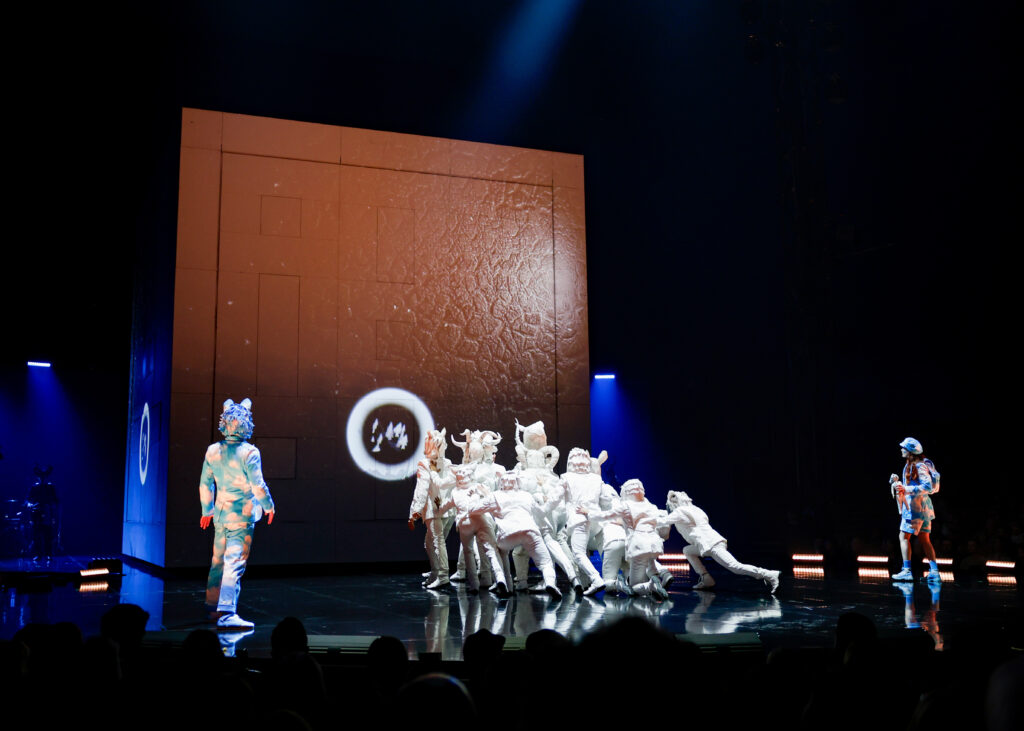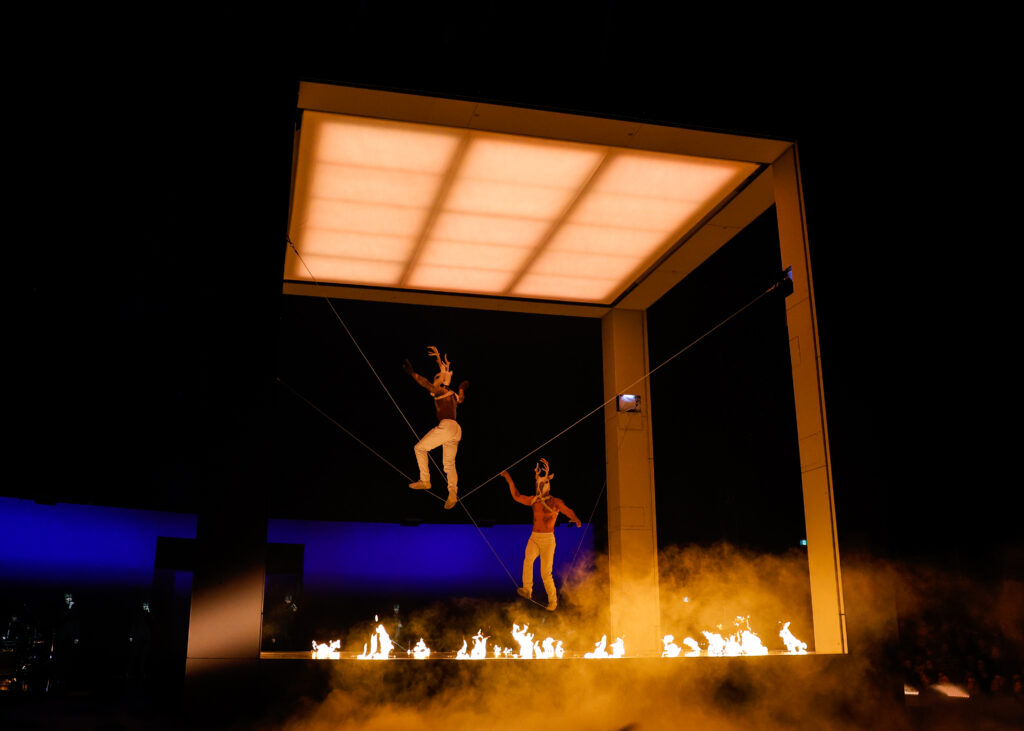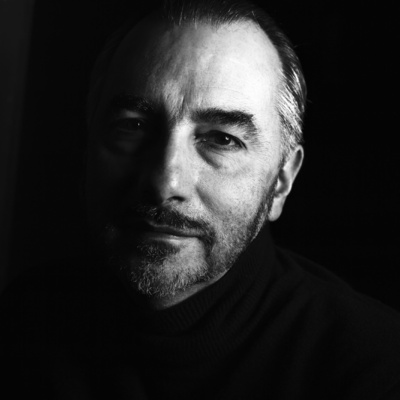An ECHO From the World and Elsewhere: Cirque du Soleil’s Newest Show Thinks Outside the Box
With the premiere of Echo in Montreal this spring, Cirque du Soleil is taking its audience around the globe—er, The Cube—in an experience that draws together people and nature in brand-new ways. Pascal Jacob reviews the company’s latest show and its inventive staging from under the tent.

Since the Renaissance, a “spectacle” has been understood as the expression of a subtle interplay of scales and proportions; a complex alchemy of differing perspectives, bursts, and intentions. With the emergence of the Théâtre des Machines in the 17th century, it has also been part of a scholarly architecture nourished by emotions, wonder, and surprises. In terms of composition and direction, beyond the classical frameworks imposed by a theatre script or an opera score, the circus necessarily imposes its own framework, and its relative lack of boundaries allows for nearly infinite freedom of conception. Each creation offers itself as a new territory to explore, as though playing an exciting building game where everything is possible. Things can then develop on the basis of an obscure intuition or a concrete feeling, a book, or even sometimes a simple word… a question of meaning or of harmony, rhythm, or color. Or an echo.
A sound poetic, impressive, and sometimes terrifying, an echo is also a reflection: a vibration that fades little by little until it disappears completely, only to be reborn, suddenly and more powerful, in an unprecedented form that multiplies itself before being extinguished in its turn. It often takes a wall to bounce and propagate the sound. In some cases, that is the starting point for everything—
A wall, a strict stone slope that rises straight up from the back of the stage, between the rampart and the cliff, probably erected there to commemorate an eternity of theatre. But it is clearly only an illusion: a game of mirrors being played by appearance and truth; an echo of the real world that will finally reveal itself to be a beautiful artifice. This visual ambiguity is both an asset and an issue in conditioning the gaze of the viewer, but it is above all a very effective trompe-l’oeil.

While we spectators note with curiosity the steep wall’s apparent ornamental dryness, something rather unusual under such a chapiteau, at the moment the show starts, it disappears in a radical modification of the space. In fact, this wall is really just a screen, a facet. An echo of something much bigger. In a few seconds, the fascinated audience discovers that this is the front of The Cube: a gigantic box whose six sides function as surfaces for play and video projection. As silent as it is imposing, the block of perfect whiteness slides to the center of the ring and pivots slowly, supporting images and bodies in search of verticality.
This unique device is a matrix. With it, Echo implements a dramaturgy of the object wherein The Cube, or box, is the exciting epicenter. Throughout the performance, this box will be cracked open, deconstructed and reconstructed, emptied out, or filled up, but always with the same magic.
With a cube that constantly oscillates between acting as a set and an apparatus, if we stick to the idea of representing objects and bodies by breaking them down into simple geometric forms and then multiplying their visible angles, then Echo could be read as a delightful allegory for cubism! But there is also something here that is part of the construction work of origami, subtly adapted to meet the requirements of a lively-in-its-essence circus show. With its ephemeral structure, The Cube creates an illusion of a perfect succession of folds, while also playing the role of a disproportionate toy, perhaps something fallen out of a gigantic chest. It imposes itself as the major point of articulation that defines a clear succession of acrobatic sequences. A solfeggio of shapes with pleats and hollows, between treasure hunting and roleplay, the cube succeeds in transforming the space into an intuitive labyrinth, a fluid territory that artists cross and, in turn, become entangled with a pile of rotating and unstable cardboard; placed in the palm of a red giant with the look of Gulliver; or suspended between the ground and cupola on strange structures, both geometric and organic.
This is probably where Echo’s strength lies: in this intuitive assembly where theatre technology bends itself to the demands of acrobats so that their virtuosity can flourish. It is a fabulous device for telling stories without words and constantly opening new artistic windows. Drawing a tense thread between the human being and the animal—two symbols of the same natural reign that will soon have no choice but to be supportive of one another—the show sometimes looks like an ethereal Carnaval des Animaux, with magnificent white silhouettes in sumptuous masks. The proximity between the species that inhabit our planet is symbolically reinforced, and we inevitably dream of seeing these unlikely hybrid creatures present in the hearts of our cities…
Echo’s acrobatic repertoire, dense and versatile, unfolds itself as a dynamic and poetic inventory. By slipping from slackwire to the Washington trapeze, Icarian games to teeterboard, and straps to hair suspension, Echo assumes a principle of classical composition, like multiplying the notches in a woven cloth, flexible enough to tighten as the show moves between attractions. The rigorous juxtaposition of dissimilar forms is Echo’s keystone. Its range of disciplines, welded together by the neutral surfaces of both the stage and The Cube, functions to create a true aesthetic syntax. Echo is a formidable illustration of the idea of demystifying what is secret, a very ambivalent notion within the formal context of classical circus. From one sequence into the next, the space reinvents itself before the eyes of spectators, constantly creating new visual perspectives—new landscapes where the purity of white is only a temporary means to conceal a new explosion of colors.
This giant cube, able to rotate slowly and reveal as much as it conceals, is a reflection of a world on the move: the incarnation of a singular universe where fascinating creatures cross paths, whether in agreement or opposition, to perform surprising feats that end up making us believe in the existence of a reassuring type of partnership. Disproportion becomes a new scale of play, and the visual variations offered by The Cube’s changing walls constitute a real lexicon that guides the eye from the smooth to the rough, from the tiny to the monumental, all in a space that does not change. This aesthetics of transformation—including inserting the sometimes almost blindingly large block that is The Cube into an empty space and thus obliterating the viewer’s gaze—is a unique interpretation of the principle of otherness that falls between emptiness and fullness. Here, without ever clinging to any hierarchy of values, the former leans on or replaces the latter… or maybe it’s the other way around…
Integrating a cubic shape into the circus ring flirts with the idea of “squaring the circle,” a well-known metaphor for doing the impossible; but more than that, it also deals with the geometry imposed by the position of the tent poles under the chapiteau. Symbolically, since the so-called “German” tent style was created in the 1930s, the four poles have formed a square, at the heart of which is the ring. The choice by Echo’s designers to inscribe another highly physically dense square inside of a frame so strongly influenced by the golden number of circus comes around, from time to time, to structure the playing space and give it a new meaning. When left open, The Cube swiftly becomes a portico and a support for an unprecedented side-by-side performance, with two flexible wires that cross and oscillate to the rhythmic evolutions of two acrobatic virtuosos. Intact and smooth, this same cube becomes a beautiful pretext for a vertical dance, dizzying in such a space. Several times, when one or more fragments—-smaller cubes, in this case—come off the wall, they act as many windows that open to make a character appear or disappear.
There is something joyful in this perpetual questioning of space, a form of disrupting the spectator’s gaze that fits in well with the idea of circus as offering fun and surprises, and breaking out of the constraints of traditional spatialization. But The Cube is also, to some extent, like a giant cabin: it is a fascinating place that at once embodies both the possibilities of childhood—a time when a chair draped in a blanket can become a mountain or an island merely by virtue of the imagination—and the adult’s sense of nostalgia. To build a cabin, whether it is rough or very elaborate, is to produce a wonderful box of chimeras. And though a cabin setting sometimes materializes with it a desire for hermitism, here the concept, with its lightness and the absence of walls, is matched instead to new expectations of revelry.
A clever staging solution with many applications, this humble cabin is a metaphorical breeding ground for the utopias of our time. And Echo, with its display that oscillates between opacity and transparency, between games of perspective and verticality, surprises and curiosity, is perhaps nothing more than an illustration of our hopes for another future.
All images from Cirque du Soleil's official ECHO press kit, with credit to photographer Jean-François Savaria and costume designer Nicolas Vaudelet....
Do you have a story to share? Submit your news story, article or press release.











